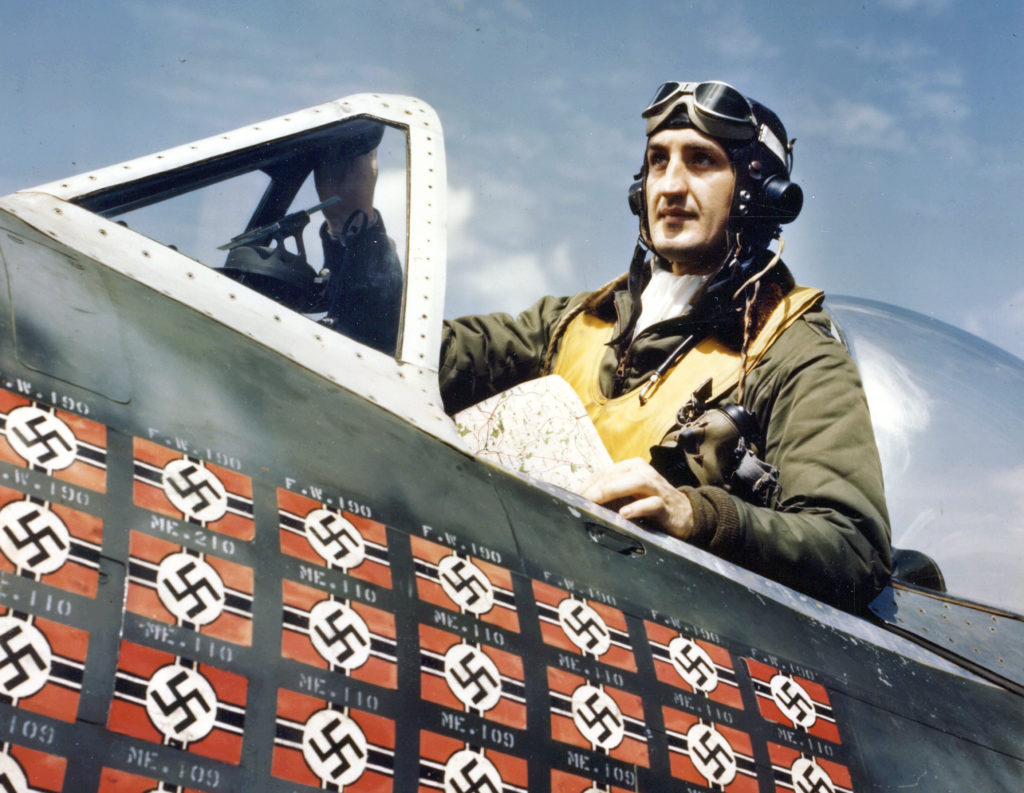
The man who would become the top American fighter ace in Europe during World War II and a jet ace in Korea almost washed out of flight training. After six hours of civilian instruction in a Taylor Cub, he was deemed too tense at the controls, and the owner of Stockert Flying Services said he “didn’t have the touch to be a pilot.” Later, during Army Air Corps primary training, he barely survived a last-chance elimination flight in a Boeing-Stearman PT-17. But assigned a new instructor, he managed to complete his flight training. Francis Gabreski never looked back, embarking on a storied 27-year Air Force career that led in his twilight years to his designation as “America’s greatest living ace.”
Born Francis Stanley Gabryszewski on January 28, 1919, he was the third of five children of Polish immigrants reared in Oil City, Pa. When eldest son Ted started high school, all the family members agreed at his suggestion to change their last name to Gabreski to make it easier to pronounce and spell. “Gabby” became Francis’ nickname for the rest of his life.
Gabreski graduated from high school in 1938 and attended Notre Dame, barely making it through his first two years. Following the lead of several friends, he filled out an application for Army Air Corps flight training, not expecting to be accepted. He passed the physical exams, however, and in July 1940 was sent to Parks Air College in East St. Louis for primary training. After his initial misadventures, Gabby went on to basic flight training in Vultee BT-13s and advanced training in North American AT-6s, graduating in March 1941. His first assignment was to a fighter group at Wheeler Field, Hawaii, flying Boeing P-26s, Curtiss P-36s and P-40s. He admitted to approaching every new fighter with some anxiety, but gradually adjusted to their distinct traits while flying about 30 hours a month and enjoying the relaxed life of a lieutenant in peacetime Hawaii. That is, until a little before 8 o’clock on the morning of December 7, 1941, when Japanese aircraft roared over Oahu.
Like a dozen other pilots in the surprise attack, Gabby helped push airplanes around on the ramp and finally got airborne in a P-36. He was eager to fight, as he wrote in his 1998 autobiography, Gabby: A Fighter Pilot’s Life. “This was it. War was on, and I was going up to do my part. I took it for granted that we probably would be getting into combat. Maybe I would shoot down an enemy plane. Maybe I would get shot down myself. I didn’t expect to be killed, but I’ll have to admit the thought crossed my mind. It didn’t matter. The main thing was to attack the enemy.”
The Japanese were long gone by the time Gabby got airborne. Life on the Hawaiian air bases gradually settled into a routine of flying patrols and practicing combat with more experienced pilots.
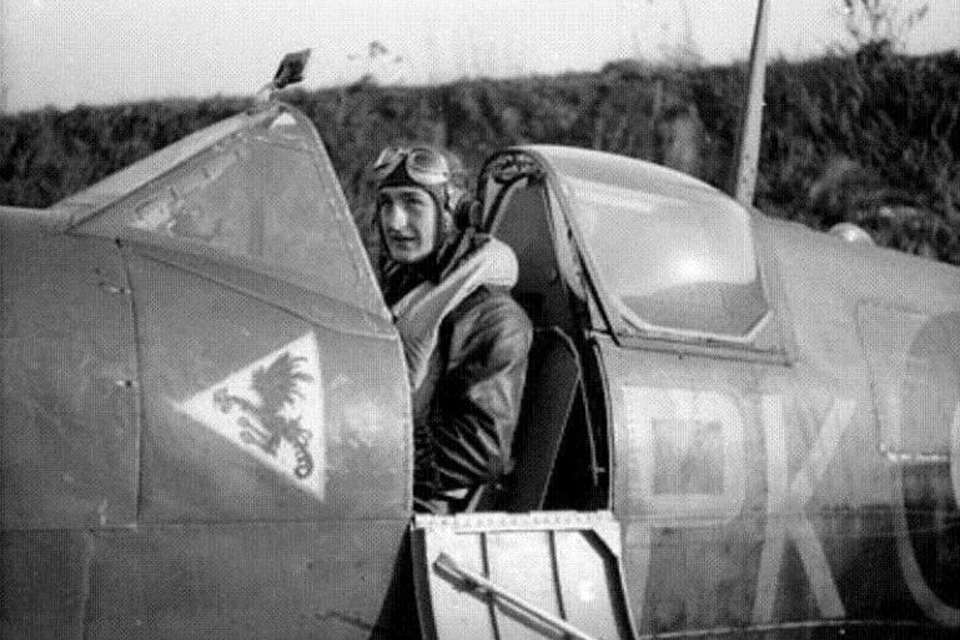
Captain Gabreski sits in the cockpit of his Supermarine Spitfire Mk. IX. “Gabby’s” Polish heritage helped him while flying Spitfires with RAF No. 315 Squadron’s experienced Polish fliers. (National Archives)
Gabby felt strongly about what the Nazis had done to Poland and was anxious to get into the war. Hearing about Polish fliers who were helping the British fight the Luftwaffe in the Battle of Britain, he got an idea: “I was a fighter pilot, and I could speak Polish. Why not see if I could get myself assigned to Europe so I could learn from the Poles and pass the information along to my own people.” His request was passed slowly upward through command channels, and in October 1942 someone in the Pentagon also decided it was a good idea. He was promoted to captain and assigned to the Eighth Air Force in England. After a “dreary” stint ferrying aircraft because no one seemed to understand why he had been ordered there, he met some of the Polish pilots, whose leader had him assigned on temporary duty to their No. 315 Squadron, flying Supermarine Spitfires, in December 1942.
The well-seasoned Poles, who had been fighting the Germans since 1939, accepted Gabreski, if reluctantly at first. Squadron Leader Tadeusz Andersz helped him transition to the Spitfire and fly the squadron’s “finger-four” formation as well as “rodeo” and “circus” maneuvers designed to entice Luftwaffe pilots to come up and fight. Andersz also taught Gabby how to hold his fire until he got close behind an enemy aircraft, as well as to resist the tendency to overshoot by going too fast. And there was that basic lesson every fighter pilot should learn: Always be alert for enemy fighters attacking out of the sun. Gabby remembered an early combat mission with the Poles that reinforced this imperative. “One moment I had looked back into an empty sky above me,” he recalled, “and the next moment it had been full of [Focke Wulf] 190s that seemed to come out of nowhere. I was lucky to have survived the lesson; a lot of inexperienced pilots didn’t.”
Gabby’s experience with No. 315 Squadron gave him confidence in his abilities as a fighter pilot, which he might not have gained had he been sent immediately to an American unit upon his arrival in Britain. Although he didn’t score any victories, he was awarded the Polish Cross of Valor. In February 1943, he was transferred to the Eighth Air Force’s 56th Fighter Group under the leadership of Colonel Hubert Zemke. Gabby transitioned into the early “razorback” models of the Republic P-47 Thunderbolt, later flying turbosupercharger-equipped versions offering better high-altitude performance.
Lieutenant Les Smith recalled 40 years later that the group’s pilots at first did not accept Gabreski. “That was unfortunate,” he said, “but I think not unexpected, since he had not trained with us in the States, had not shipped with us, and had no personal relationships within the group. There was another unfortunate factor over which he had no control—his rank as captain. This put him in direct competition with the old captains already assigned and in indirect competition with our older first lieutenants who hoped to become captains. We new second lieutenants were not really involved in this rivalry, but we held the older pilots in great esteem, and if they didn’t like the new stranger, we weren’t going to be too friendly either. We eventually recognized Gabby’s superior ability as a pilot and his very aggressive fighting spirit, and we respected him for them.”
After several missions under Zemke’s leadership with no enemy opposition, Gabby damaged an Fw-190 over Holland on May 15 in his first active combat action with the 56th. He was gradually given more responsibility as flight leader, squadron operations officer and squadron commander, as well as a promotion to major. Although he gained confidence on every flight, a simple mishap almost ended his career as a fighter pilot. He was hand-propping a Piper L-4 for a short flight when the engine backfired, causing the prop to kick back, barely missing his head and striking his right hand. One finger bled profusely, attached only by a piece of skin and a tendon. At first when Gabby was whisked to a nearby hospital it seemed the finger couldn’t be saved, but a surgeon managed to set it in a permanently curved position. Gabby was grounded for the next three months.
Gabreski’s first mission following his return to duty was disappointing, since he was forced to break off when his belly tank malfunctioned, while the remaining pilots downed five Messerschmitt Me-110 twin-engine fighters with no losses. That day, August 17, 1943, was called “Black Thursday” after the bomber force they were escorting lost 60 planes.
Gabby scored his first confirmed kill, an Fw-190, on August 24. He described his feelings afterward: “That evening before I went to sleep I thought about the implications of what I had done that day. I had killed a man, I was sure of it. Yet I felt no remorse. It wasn’t that I particularly wanted to kill people, Germans or otherwise. But this was war, and for three years I had been preparing myself mentally and physically for the day when I would begin shooting down enemy aircraft. Yes, there was a man inside of the Fw-190 I’d destroyed today, but I never saw him, never heard him, never knew his name or what he looked like.”
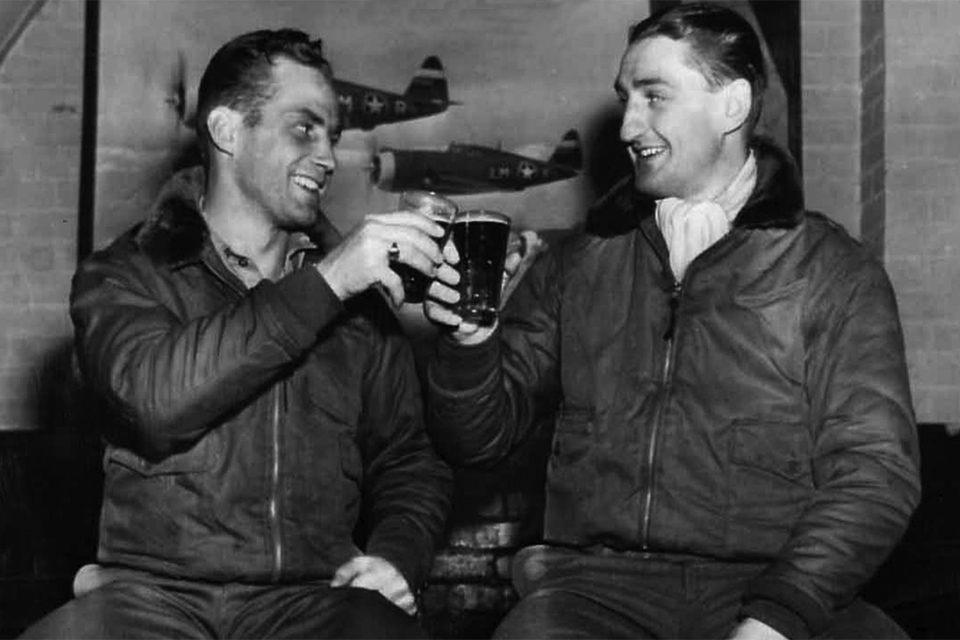
During the weeks that followed, Gabreski downed two more 190s, then became an ace with five victories on November 26. He was leading a bomber escort flight when they were attacked by a group of Me-110s. Gabby was making a stern attack on one of them when it suddenly exploded. Large pieces of the Messerschmitt skimmed off his canopy and smashed into the P-47’s right wing. His plane was still flyable, though, so he climbed back up to continue the fight and downed a second 110. The 56th set a record that day with 23 confirmed victories, and Gabby was awarded the Distinguished Service Cross for his leadership.
From then on, Gabreski’s logbook reflects an ever-growing succession of Fw-190, Me-109 and Me-110 kills, with only minor damage to his P-47. However, one cannon hit from an Me-109 nearly cost him his foot when it blasted through his cockpit, hit a rudder pedal and tore into his boot, fortunately causing only minor injuries.
Meanwhile, larger fuel tanks were installed on the P-47Ds, giving them greater range, and in early 1944 Eighth Air Force commander Maj. Gen. James H. “Jimmy” Doolittle authorized fighters to leave the bombers and seek out enemy aircraft wherever they could be found. As a result, the fighters were able to destroy scores of German planes in the air and on the ground. Gabby shot down three aircraft during “Big Week” missions in February 1944, and kept adding to his score in competition with some of the other aces of that period. During his most productive mission, on May 22, he downed three Fw-190s and scored a “probable.”
On July 5, Gabreski became the top American ace in the European Theater of Operations—with 28 victories—while leading the group on an escort mission over a German air base in France. After the bombers made their run, he led one flight on a strafing attack on the field, during which he shot down a defending Me-109. His 61st Squadron’s five kills that day brought its total to 230, the best record in the ETO.
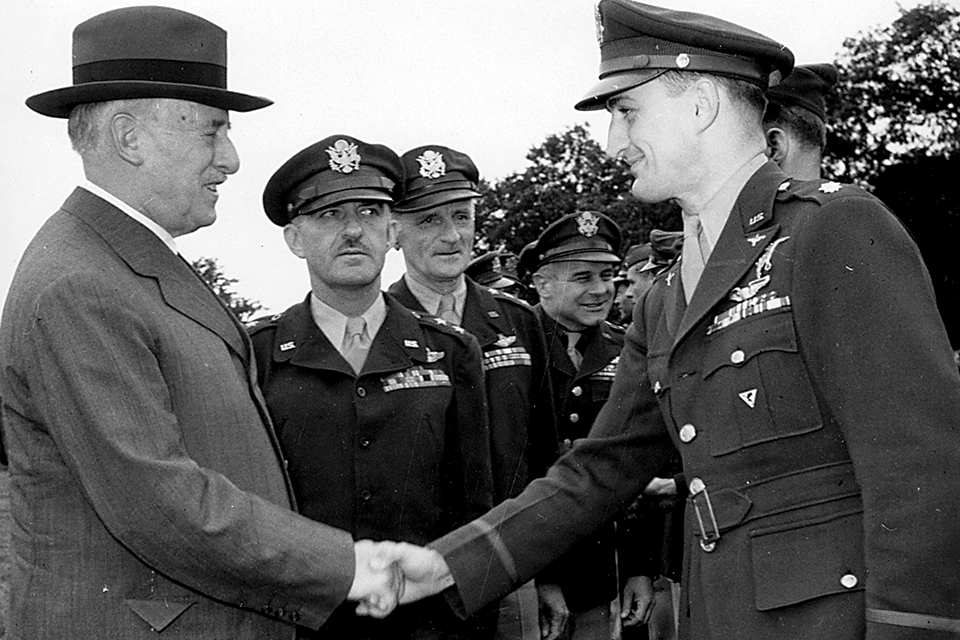
The publicity resulting from Gabby’s 28th victory was almost overwhelming for him. “I hardly had a moment to spare doing what I was in England to do,” he said, “which was to fly airplanes. I felt I had an obligation in the war, just like everybody else. But I was being taken out of that environment and put on a little pedestal. It was an awkward position for me, and I never did fit into it very well.”
Army Air Forces leaders wanted Gabreski to return home and take advantage of his fame to sell war bonds, and he was scheduled to depart the theater in late July after his 165th mission. Gabby packed his bags and was about to step aboard a Douglas C-54 to leave for the States when he heard of a mission escorting Consolidated B-24s to bomb Russelheim, Germany. Unable to resist what sounded like an excellent opportunity to score again, he took his bags off the C-54 and asked to make one final mission “to close out my tour with a bang.”
The raid went well, with Gabreski leading the squadron. After the bombers had dropped their loads and headed for England, he looked for targets of opportunity on the ground. Gabby spotted an airfield at Bassenheim and sent two flights down, then followed them to treetop level. He lined up on a parked Heinkel He-111 and watched it burst into flames. Encountering only light flak over the field, he decided to make another run at an even lower altitude—so low that his prop scraped the ground, causing severe engine vibrations. Hydraulic fluid immediately covered his windscreen, and he was forced to crash-land in a farmer’s field.
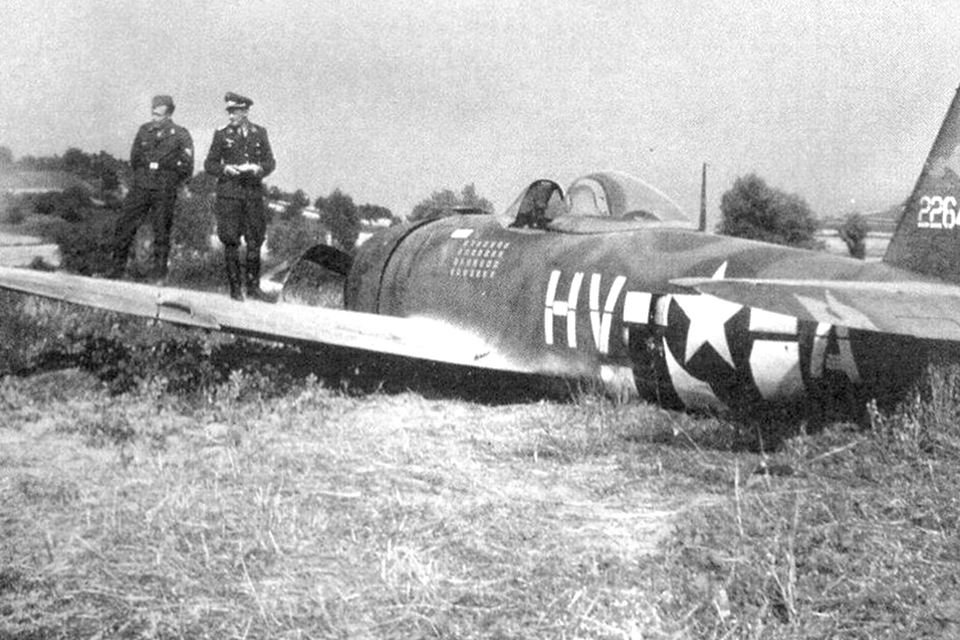
Dazed but unhurt, Gabby knew he was hundreds of miles inside Germany and needed to avoid capture. He ran into the woods and for the next five days managed to elude searchers, but was finally apprehended by a policeman who turned him over to the military at Oberursel on July 25. Hanns Scharff, an affable English-speaking German intelligence officer, interrogated him. “Hello, Gabby,” he greeted him. “We have been waiting for you for a long time.”
Gabby was transferred to Stalag Luft I at Barth on the Baltic Sea, north of Berlin. By then his former group commander, Colonel “Hub” Zemke, who had been shot down in October 1944, was the camp’s ranking officer.
Gabby’s most enduring memory of the next nine months as a POW besides boredom was increasing hunger. Red Cross parcels kept the prisoners from starving, but as the war got worse for Germany, the parcels stopped coming. The winter and early spring of 1945 was a horrific period marked by subzero temperatures and increasingly inadequate sustenance. On April 30, however, Russian troops liberated the camp. Many of the captives wanted to open the gates and take off, but Zemke ordered them to stay put and wait for aircraft to fly them out to Camp Lucky Strike, near Le Havre, France.
Gabby managed a detour to visit his old unit in England and then persuaded authorities to allow him to make a flight directly to New York. He hurried to Prairie du Chien, Wis., to reunite with his fiancée Kay Cochran, whom he had courted during his days in Hawaii. They made plans for a June wedding, and Gabby went home to Oil City for a hero’s welcome and a series of public appearances selling war bonds.
Like so many veterans after World War II, Gabby didn’t know what to do next. He wanted to complete his college degree as well as continue flying. He was assigned as a test pilot at Wright Field, Ohio, but also received a job offer from Douglas Aircraft Co. as a foreign sales representative. He accepted the offer in May 1946 and toured Mexico, Argentina, Brazil and Chile attempting to sell the Douglas DC-6, a pressurized version of the DC-4. The trip was not very successful, though, and Gabby found the traveling life and especially being away from his wife, now with one child and another on the way, uncomfortable. He decided to see if he could rejoin the Army Air Forces, and was pleased to be accepted in April 1947 as a regular lieutenant colonel assigned to command the 55th Fighter Squadron, flying North American P-51s at Shaw Air Force Base, S.C. “It was great to get back in the cockpit again,” he said, “and it was great to be a squadron commander in peacetime conditions. The P-51 was a beautiful airplane with a lot of range. It was a joy to fly.”
Gabby still wanted to get that degree, however, so he requested assignment to a Russian language program at Columbia University for eventual duty as an air attaché. The program was canceled after one year, but Gabby persuaded the Air Force to allow him to continue, and he graduated in August 1949 with a B.A. in political science.![]()
His next assignment took him to Selfridge Air Force Base in Michigan to command the 56th Fighter Group, which was then transitioning to the Lockheed P-80 Shooting Star, the Air Force’s first operational jet fighter. It was a great leap forward for the prop plane pilots, but the early jets had their share of difficulties. The jet engines had a voracious appetite for fuel at low altitudes, and Gabby admitted to nearly running out of gas several times. The jets also suffered from slow engine acceleration, and in addition there was the possibility of a compressor stall if the throttle was advanced too quickly.
In June 1950, the peacetime routine changed drastically for American fighter pilots when Communist North Korean forces invaded South Korea. The 56th exchanged its P-80s for North American F-86 Sabrejets, and Gabby was promoted to full colonel in March 1950, then transferred to the 4th Fighter-Interceptor Wing (FIW), based in Japan with units in Korea. He embarked on his second combat career as the deputy wing commander, and could fly with any squadron he chose to learn about tactics and techniques in a new kind of war.
On June 17, 1951, Gabby took off with some trepidation on his first Korean War mission. “I searched the deep blue sky for signs of enemy fighters and began to wonder if I still had what it took to fly combat,” he recalled. “I was thirty-two years old now, and my eyesight might not be as sharp as it was in Europe. Had my reflexes slowed? Would I still have the old fire in my belly that made me want to climb up their tails before opening fire? Only time would tell.”
When Communist MiG-15s appeared, he experienced one of the frustrations that dogged all F-86 pilots at that time. The higher the Sabres flew, the more unstable they became, while the MiGs could fly higher and loiter longer because they were lighter and were close to their bases on the Chinese side of the Yalu River. That international border with North Korea was theoretically a line over which American interceptors could not cross, since China was not officially involved in the war. As Gabby led a flight along “MiG Alley” near the Yalu, no MiGs took the bait, and he was as disappointed as the other Sabre pilots at not being able to attack the enemy fighters at their bases.
Leading a flight of four F-86s on July 8, Gabby saw some F-80s and MiGs scrambling at 10,000 feet and barreled down behind a MiG that was breaking away from the fight. As he had in Europe, he got on its tail, held his fire until close enough, then blasted it to pieces with his six .50-caliber machine guns. He knew now he was still able to attack an enemy aircraft and make a kill.
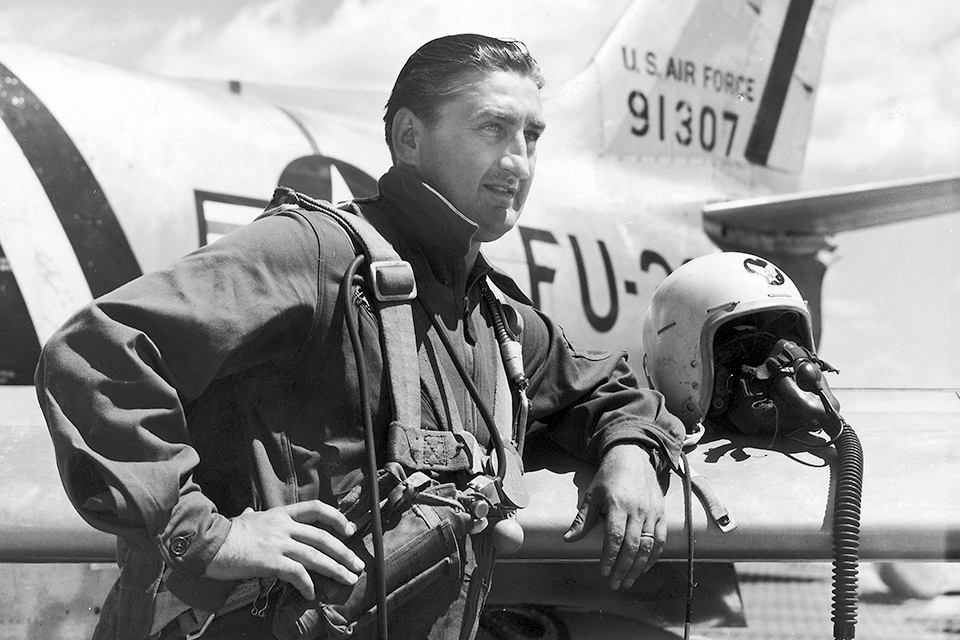
Around this time, the Americans noted that the MiG pilots seemed more skilled, and suspected they were facing experienced Russian pilots—though they couldn’t be sure. (That suspicion was officially confirmed after the Soviet Union’s fall.) There was always the temptation to cross the Yalu River after them, and Gabby and others admitted they sometimes did so if they thought they could shoot down a MiG without going too far.
Gabby got his second victory, over Pyongyang, on September 2. A stray MiG-15 was heading home when he took it out with a deflection shot. A month later he downed another one. Meanwhile, Communist air tactics changed. Taking advantage of their numerical superiority, they formed two long lines of 50 to 60 fighters—“MiG trains”—flying down both sides of the peninsula. More F-86s and pilots were clearly needed, so two new wings were formed in November, with Gabby commanding the 51st FIW. Its first mission was on December 1.
Gabby flew all of the 51st’s early missions, and devised a new tactic known as the “fluid four,” a more flexible version of WWII’s finger-four that was better suited to jets. By January 1952, the wing had destroyed 26 MiGs with only seven losses. Gabreski got one on January 11, and shared credit for another on February 20.
It wasn’t all war all the time for Gabby, especially when winter weather prohibited operations. Although he didn’t make it a practice to flaunt his faith, he was a deeply religious and compassionate man despite his “killer” military reputation. The wing chaplain had located an orphanage in Suwon that was crowded with poorly clothed, sick and starving children. When Gabby heard about it, he had the wing sponsor the orphanage and appealed to the citizens of Oil City for help. They responded with mountains of donated clothing, medicine, school supplies and building materials.
Combat operations picked up with the clearing spring weather. Gabby was leading a flight along the Yalu River on April 1 when he sighted the contrails of 30 MiGs climbing up from Antung in the safety of Chinese airspace. He was very conscious of the imaginary line he should not cross, but he couldn’t pass up the opportunity. The sun was behind his formation as 15 MiGs came out of the contrails, and Gabby pounced on a straggler returning to his Chinese base. He fired until the enemy pilot blew off his canopy and bailed out. That brought his jet tally to 5½ victories and made him the first American to become an ace in two wars.
Concerned that he would be disciplined when his flight returned, he called his pilots “so we could coordinate our combat reports, blurring the fact that we had crossed the Yalu to attack the MiGs.” No one ever challenged their reports.
Gabby scored again on April 12, to finalize his total at 6½. Combined with his 28 kills in Europe, that made him the third-highest-scoring American ace of all time, after Lockheed P-38 pilots Dick Bong and Thomas McGuire. He was grounded after completing his 100th mission, returning Stateside to a ticker tape parade in San Francisco and a visit with President Harry Truman at the White House. The airman commented in his memoirs that “it was quite a thrill for a Polish kid from Oil City who had almost flunked out of flight school.”
Gabby remained in the Air Force and served with the Office of Flight Safety in California, investigating aircraft accidents for two years. He then attended the Air War College at Maxwell Air Force Base, Ala., for a year, transferring to command a tactical fighter wing at Myrtle Beach, S.C., that was being equipped with supersonic North American F-100 Super Sabres.
The aerial refueling capability of the F-100 and fighters like it enabled the Air Force to quickly send reinforcements to trouble spots around the globe. Gabby found that in-flight refueling required special training, and after flying a number of such missions, described them as “a dramatic experience.” He said later, “I would rather attack a squadron of Fw-190s alone in a P-47 than face one of those drogues again in an F-100. That was nightmare fodder.”
In July 1960, Gabby was transferred to Kadena Air Base on Okinawa to command the 18th Tactical Fighter Wing, another F-100 unit. Two years later he was ordered to Hawaii as inspector general for the Pacific Air Forces, and in 1964 was transferred to command the 51st Fighter Wing at Suffolk County Air Force Base on Long Island.
In 1967 nearby Grumman Aerospace Co. offered Gabby a job as a marketing vice president. He accepted and retired from the Air Force on October 31, with 27 years’ service. With the exception of a 2½-year stint in 1978-81 as president of the Long Island Railroad, he stayed with Grumman until his retirement in 1987.
Gabby lost his wife Kay in an auto accident on August 6, 1993, and he died of a heart attack on January 31, 2002. He is survived by three sons and six daughters.
Francis S. Gabreski flew 289 combat missions in two wars and destroyed 34½ enemy aircraft. He was enshrined in the National Aviation Hall of Fame in 1978 “for outstanding contributions to aviation by his displaying unusual valor and new combat tactics in becoming a leading ace in two wars and by devotion to duty in peace.” In 1992, Suffolk County Airport was renamed in Gabby’s honor.